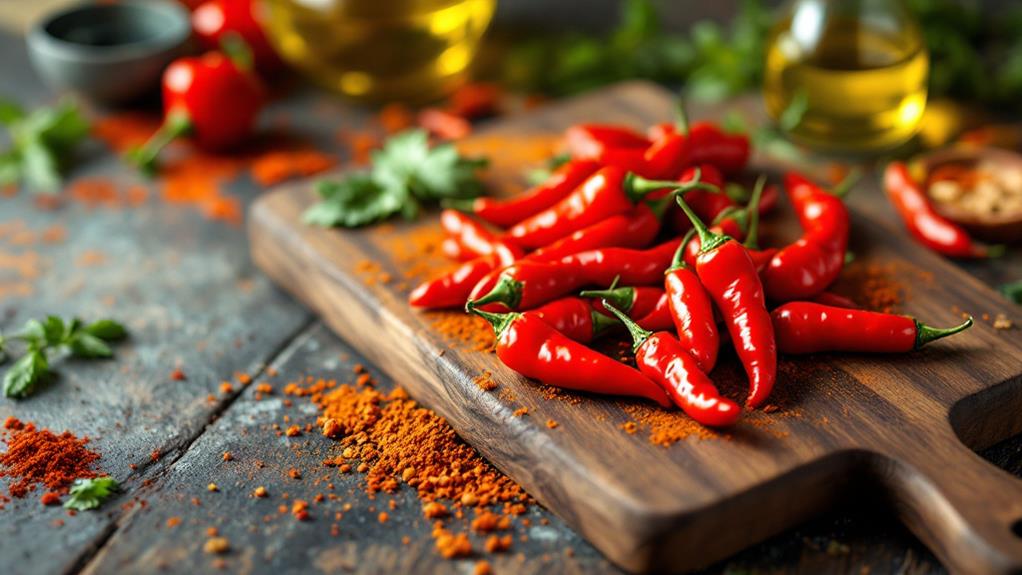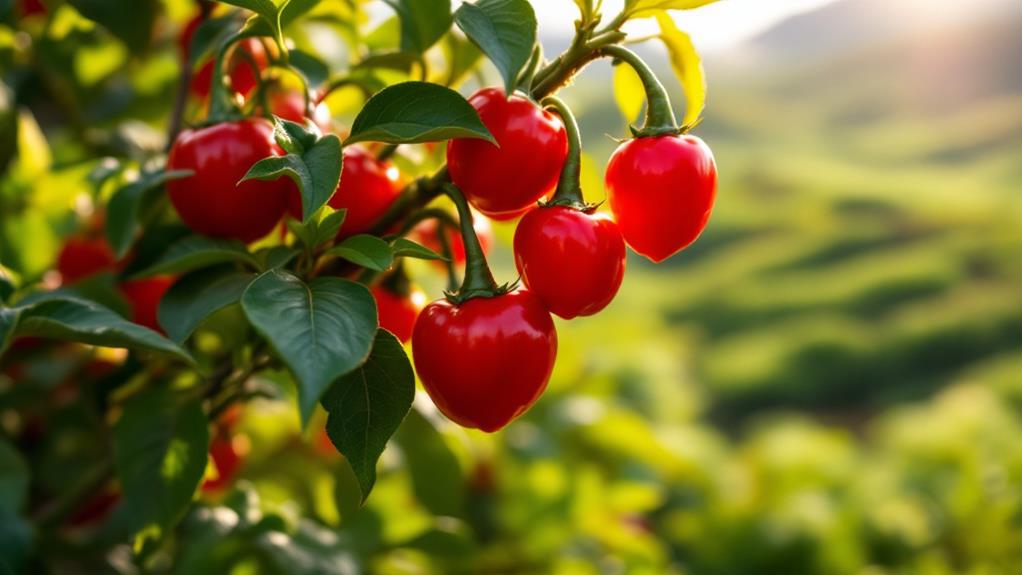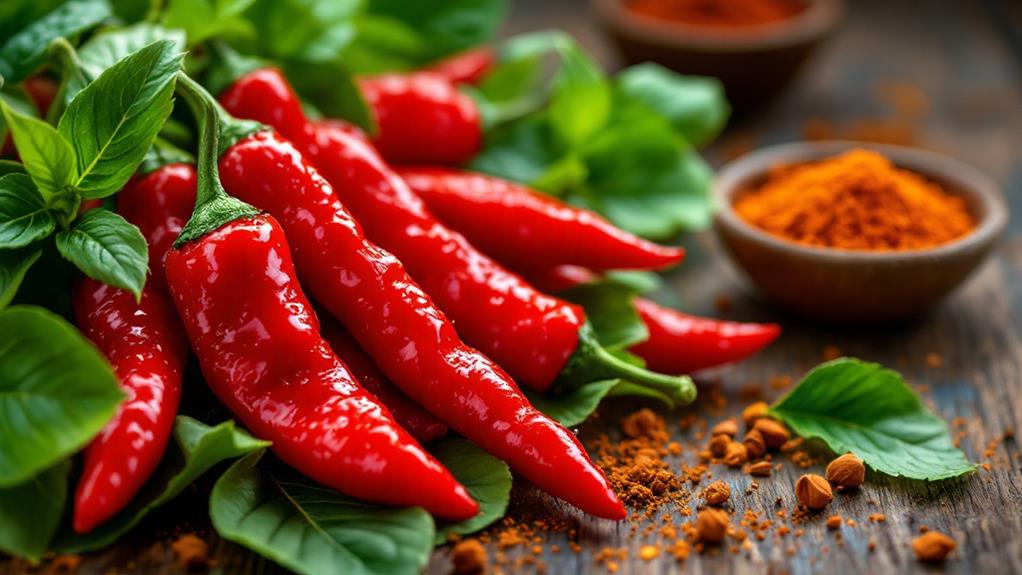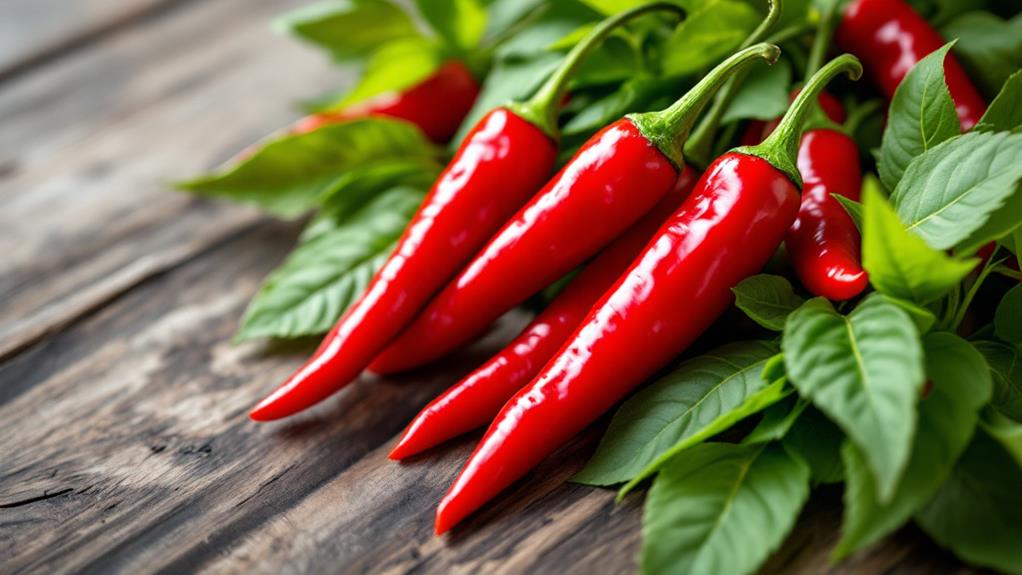The Banana Pepper: Sweet, Tangy, and Mild
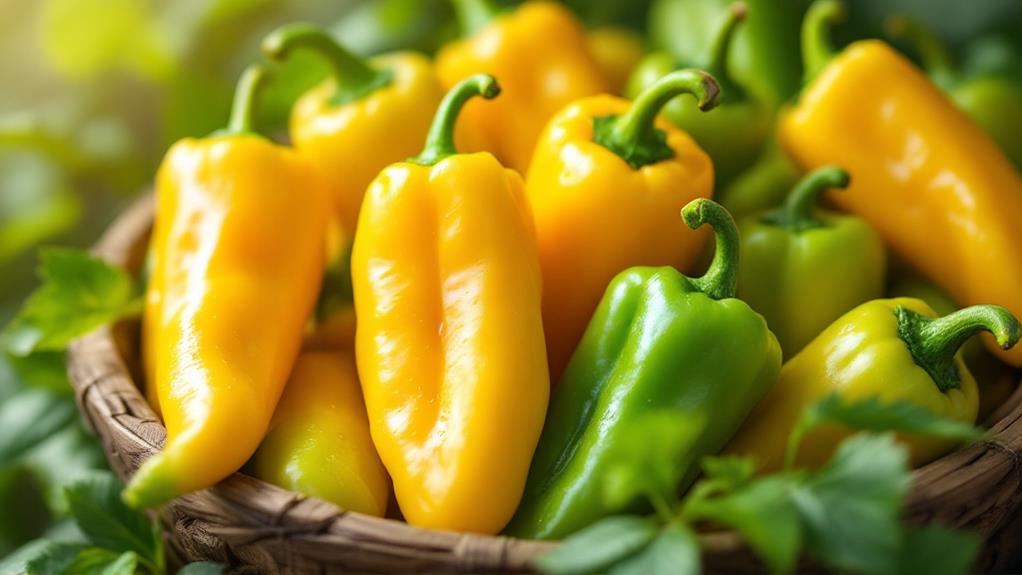
You'll love adding banana peppers to your meals for their sweet, tangy, and mild flavor. These peppers resemble bananas in shape and color and score just 0-500 on the Scoville Heat Unit scale, making them perfect for sensitive palates. Their natural sweetness improves savory dishes, while their tanginess shines when pickled. Try them raw in salads, grilled for extra texture, or stuffed with cheese and meats. Their mild heat won't overpower other flavors, adding a delightful crunch to your creations. Uncover new ways banana peppers transform dishes with a tantalizing twist. There's so much more these peppers have to offer.
Understanding Banana Peppers
When you dig into the world of banana peppers, you'll uncover a chili pepper that's as intriguing as it is mild. Known also as yellow wax peppers, these lively, elongated beauties resemble bananas in shape and color, which is exactly where they get their name. Measuring between 0-500 Scoville Heat Units, banana peppers offer a gentle heat that's about five times milder than the mildest jalapeño. This makes them perfect if you're looking to add a touch of spice without overwhelming your taste buds.
Banana peppers boast a sweet and tangy flavor, providing a delightful balance that's both invigorating and versatile. You can enjoy them raw for a crisp, garden-fresh taste, or grilled for a smoky twist. However, it's their pickled form that really shines in culinary use. Often found sliced into rings, pickled banana peppers are a staple in many kitchens, adding a mild tangy punch to pizzas, salads, and a host of other dishes. Their sweet and tangy notes brighten up meals, making them a favorite topping or ingredient without overpowering the other flavors in your dish.
Taste and Flavor Profile
Discover the taste and flavor profile of banana peppers, and you'll find a delightful blend of mild heat, sweetness, and tanginess. These peppers offer a unique taste experience that improves a variety of dishes. When you bite into a banana pepper, you're met with a mild flavor that's not overpowering, making it a fantastic enhancement to your favorite recipes. The tangy flavor comes particularly to life in pickled banana peppers, where the vinegar brine adds a zesty kick that's perfect for tacos or nachos.
Here's what makes banana peppers so special:
- Mild Heat: With a Scoville Heat Unit (SHU) range of 0 to 500, banana peppers are much milder than jalapeños, making them accessible to those sensitive to spicy foods.
- Sweetness: Their natural sweetness makes them a versatile ingredient, complementing both savory and sweet dishes.
- Tangy Flavor: Especially pronounced in pickled form, the tanginess adds an intriguing dimension to any meal.
- Crunchy Texture: Enjoy them raw in salads or sandwiches, where their crisp texture provides a revitalizing bite.
Whether raw or pickled, banana peppers bring a mild yet flavorful enhancement to your culinary adventures.
Heat Levels Explained
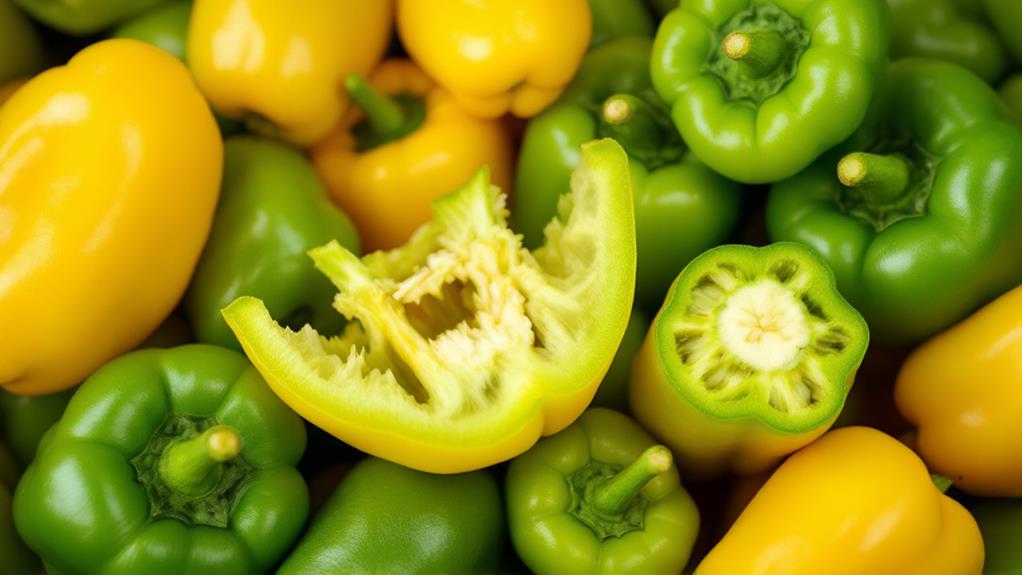
While banana peppers are celebrated for their delightful taste, understanding their heat levels adds another layer to appreciating these adaptable ingredients. Banana peppers measure between 0-500 Scoville Heat Units (SHU), placing them among the mildest in the pepper family. If you're someone who shies away from spicy foods, you'll find banana peppers a perfect choice. They offer a gentle heat that improves dishes without overpowering them.
To put it in perspective, banana peppers are approximately five times milder than the mildest jalapeño, which ranges from 2,500 to 8,000 SHU. This makes them an excellent option if you enjoy a slight kick without the fiery aftermath. Compared to similar peppers, Anaheim peppers range from 500-1,000 SHU, and Cubanelle peppers can measure between 0-1,000 SHU. Therefore, banana peppers are a safe bet for those who prefer mild heat levels.
The Scoville Heat Scale categorizes banana peppers as a mild option, which means they seamlessly blend into different dishes. Their subtle heat and tangy flavor make them ideal for anyone seeking to add a touch of spice without overwhelming the palate. Enjoy experimenting with these mild peppers in your culinary creations!
Culinary Uses
Regardless of being in salads or sandwiches, banana peppers bring a sweet, tangy crunch that improves the entire dish. Their versatility makes them a favorite in many culinary uses. You can enjoy them raw, but they also shine when incorporated into other foods, bringing a mild acidity that complements richer flavors perfectly.
One of the most popular culinary uses of banana peppers is pickling. Pickled banana peppers are not only delicious but also incredibly versatile. Here's how you can use them:
- Toppings: Add them to pizzas and nachos for an extra layer of flavor.
- Appetizers: Slice them into rings for easy use as a garnish or in appetizers.
- Stuffed Peppers: Fill them with your favorite ingredients for a colorful party platter.
- Grilling: Their firm texture holds up well on the grill, making them a great supplement to backyard barbecues.
These peppers can transform simple dishes into something special. Regardless of you're garnishing a burger or stuffing them with cheese, their sweet tangy crunch will leave your taste buds satisfied. So, next time you're cooking, consider the humble banana pepper for a delicious twist.
Growing and Harvesting
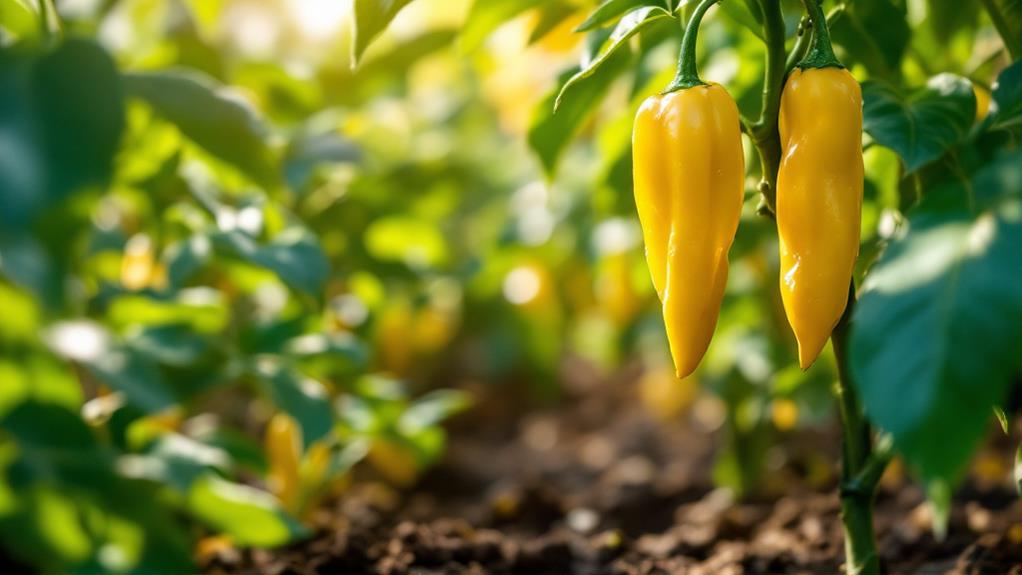
Growing banana peppers is a rewarding endeavor for any gardener, especially if you're in a warm climate. These peppers thrive in full sun and flourish in USDA hardiness zones 5-10. Start by planting them in well-draining soil, guaranteeing they're in an area that gets plenty of sunlight. Your banana pepper plants will typically grow to a height of 1-2 feet, making them manageable for most garden spaces.
As the growing season progresses, keep a close eye on your peppers. You'll notice the peppers becoming firm and turning a lively yellow-green, signaling that they're almost ready for harvesting. This usually happens around 60-80 days after planting. Although they can ripen further to orange or red, harvesting them when they're yellow often assures the best flavor and texture.
When harvesting, gently twist the peppers off the plant or use a pair of scissors to avoid damaging the stems. Once picked, you can enjoy their sweet, tangy taste in assorted dishes. Remember, though, to store them properly to maintain their freshness. Keeping them at peak quality makes all your hard work in growing worth it.
Storing Banana Peppers
To keep your freshly picked banana peppers at their best, store them in a plastic bag in the refrigerator's vegetable drawer, ideally at a temperature of 40-45°F. This approach helps maintain their firmness and lively color, guaranteeing you enjoy their sweet and tangy flavor for as long as possible. Properly storing banana peppers this way can extend their longevity, allowing them to last for 2-3 weeks.
When selecting banana peppers for storage, remember:
- Firmness is Key: Choose those that are firm and bright yellow-green. It's best to avoid peppers with soft spots to guarantee they last longer.
- Temperature Matters: Keep them in the vegetable drawer of your fridge, where they can stay at an ideal temperature of 40-45°F.
- Plastic Bag Use: A plastic bag helps retain moisture and prevents the peppers from wilting.
- Alternative Storage: If you want to store them for even longer, consider pickling. This not only extends their shelf life but also improves their flavor.
Banana Peppers vs. Pepperoncini
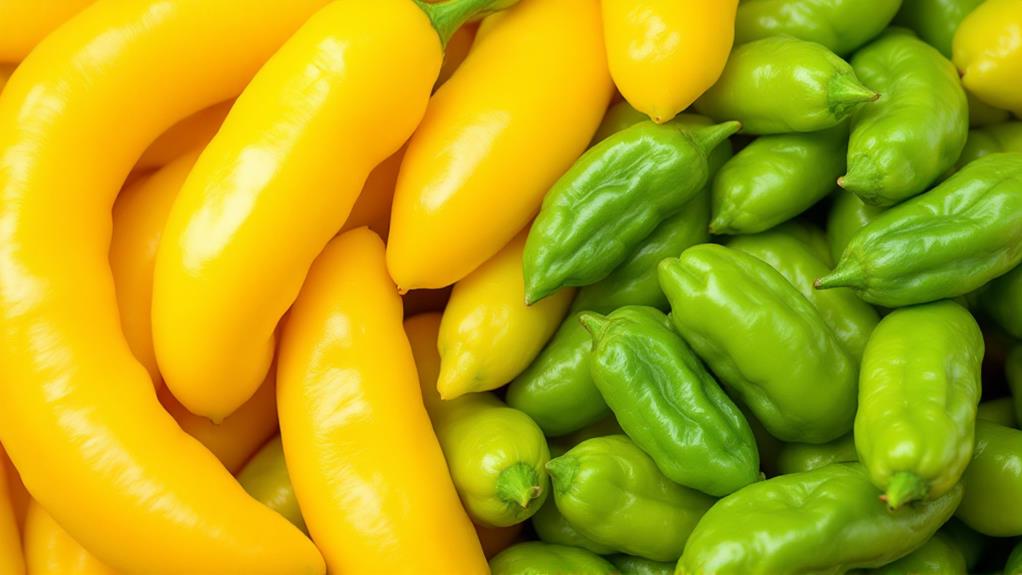
When comparing banana peppers to pepperoncini, you'll notice both belong to the Capsicum annuum family and share similar mild heat levels, ranging from 100 to 500 Scoville Heat Units (SHU). Despite this similarity, they differ considerably in appearance and flavor. Banana peppers are known for their bright yellow, smooth skin, making them visually appealing in salads and dishes. In contrast, pepperoncini have a wrinkled texture and are often greenish, lending a different aesthetic.
In terms of taste, banana peppers offer a delightful sweet and tangy profile, while pepperoncini carry a slight bitterness. This distinction becomes more pronounced when you enjoy them raw. However, once pickled, these flavors tend to converge, blurring the differences and making them both popular in numerous culinary uses.
When deciding which pepper to incorporate into your meals, consider their unique characteristics. Banana peppers shine in salads, sandwiches, and pizzas, adding a sweet, tangy kick with mild heat. Meanwhile, pepperoncini are staples in Italian dishes, often used as a garnish that provides a mild heat and slight bitterness. Understanding these differences helps you choose the right pepper for your culinary adventures.
Popular Recipes
Banana peppers are a versatile ingredient that can improve numerous recipes with their mild sweetness and tang. Regardless if you're cooking for a crowd or just yourself, these peppers are sure to add a delightful twist to your meals. Here are some popular recipes you can try:
- Stuffed Banana Peppers: Fill these peppers with your favorite ingredients like cheese or meats. The mild flavor of banana peppers pairs perfectly with a variety of fillings, making them a delicious appetizer or main dish.
- Loaded Sheet Pan Nachos: Add banana peppers for a colorful and flavorful twist on this classic party dish. Their slight tang complements the cheesy goodness, making your nachos an instant hit.
- Cheesy Pepper Burgers: Incorporate banana peppers into your burgers for a crunchy texture and subtle tang. They're perfect for grilling season and add an unexpected burst of flavor to every bite.
- Chicken Wings: Use banana peppers to create flavorful chicken wings. Their mild sweetness, combined with savory spices, results in a delicious appetizer that everyone will love.
Experimenting with banana peppers in these recipes will surely impress your taste buds and your guests!
Where to Buy
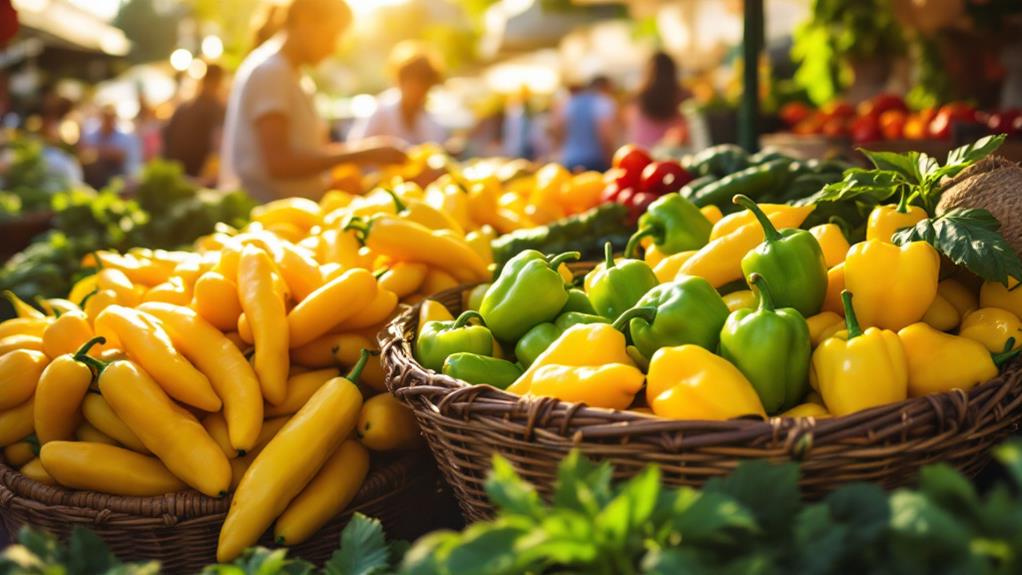
Finding banana peppers is a breeze, as they're available in multiple forms to suit your culinary needs. If you prefer fresh banana peppers, head to local farmers' markets or grocery stores where they're often stocked in the produce section during peak seasons. Supporting local farmers not only guarantees freshness but also contributes to your community's agriculture.
For those who love the convenience of pickled varieties, jarred options are widely accessible. Supermarkets typically offer these tasty tangy slices in the condiment aisle, situated among other pickled vegetables. Popular brands like Mezzetta provide different jar sizes, such as 16 fl oz and 32 fl oz, making it simple to find the perfect amount for your recipes.
In today's technological era, online retailers like Amazon and specialty food websites make it easy to purchase banana peppers without leaving your home. You'll find a variety of products, including fresh, pickled, and other jarred options, often with the convenience of home delivery. Moreover, consider exploring community-supported agriculture (CSA) programs, which might offer direct purchases from growers, guaranteeing the freshest harvests while supporting local agriculture. With these options, you're sure to find the perfect banana peppers for your culinary adventures.

